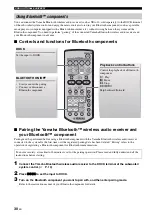
38
En
ADDITIONAL INFORMATION
■
AIR SURROUND XTREME
New surround technology developed by Yamaha enables
surround sound with fewer speakers. In comparison to
traditional front surround technology, the AIR
SURROUND XTREME provides a natural surround
sound field.
■
Channel (ch)
A channel is an audio type that has been divided based on
range and other characteristics.
Ex. 7.1 channel
•
Front speakers, Left (1ch), Right (1ch)
•
Center speaker (1ch)
•
Surround speakers, Left (1ch), Right (1ch)
•
Surround back speakers, Left (1ch), Right (1ch)
•
Subwoofer (1ch × 0.1
*
= 0.1ch)
* In contrast to a full 1-channel band, a component designed to
enhance low frequency sound for added effect.
■
Dolby Digital
Digital surround sound system which is developed by
Dolby Laboratories provides completely independent
multi-channel audio. With 3 front channels (left, center,
and right) and 2 surround stereo channels, Dolby Digital
provides five full-range audio channels. With an
additional channel especially for bass effects (called LFE,
or low frequency effect), the system has a total of 5.1-
channels (LFE is counted as 0.1 channel). By using 2-
channel stereo for the surround speakers, more accurate
moving sound effects and surround sound environment
are possible than with Dolby Surround.
■
Dolby Pro Logic II
It is an improved matrix decoding technology that
provides better spatiality and directionality on Dolby
Surround programmed material; provides a convincing
three-dimensional sound field on conventional stereo
music recordings; and is ideally suited to bring the
surround experience to automotive sound. While
conventional surround programming is fully compatible
with Dolby Pro Logic II decoders, soundtracks will be
able to be encoded specifically to take full advantage of
Pro Logic II playback, including separate left and right
surround channels.
■
DTS
Digital surround sound system developed by DTS, Inc.,
which provides 5.1 channel audio. With an abundance of
audio data, it is able to provide authentic-sounding effects.
■
PCM (Pulse Code Modulation)
A signal that is changed to digital format without
compression. A CD is recorded with 16-bit sound at 44.1
kHz, while DVD recording is anywhere from 16 bits at 48
kHz to 24 bits at 192 kHz, which makes it a higher quality
sound than CD.
■
Sampling frequency
The number of sampling (process for digitalizing analog
signals) per second. In principle, the higher the sampling
rate, the wider the frequency range that can be played
back, and the higher the quantized bit rate, the finer the
sound that can be reproduced.
Glossary
















































